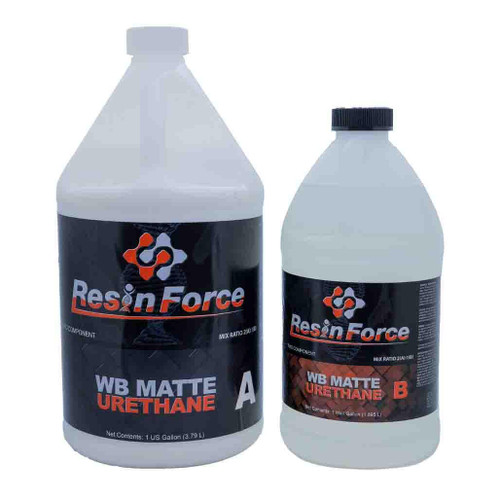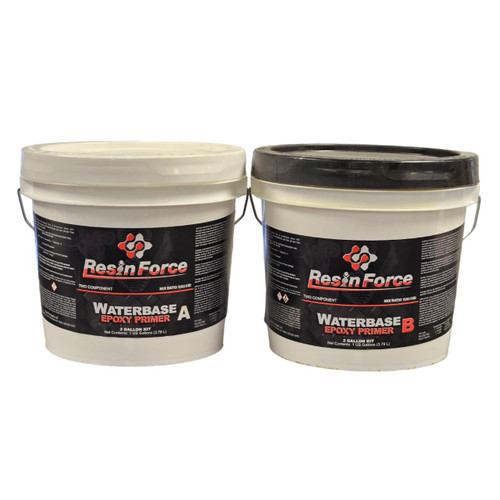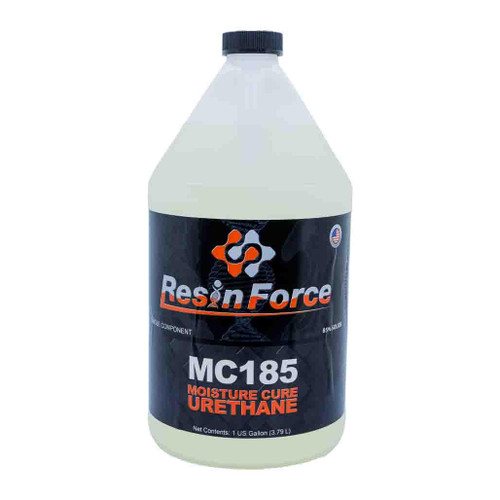Product Description
ResinForce Water Based Urethane Gloss (Mix 4:1) 1.25 Gallon Kit
WB Gloss Urethane is a high gloss, two-component water based aliphatic polyurethane with excellent color enhancement properties. WB Gloss Urethane has excellent adhesion and hardness properties as well as abrasion, hot tire, and chemical resistance. Gloss Urethane is low VOC and low odor with multiple uses.
MOISTURE TESTING: Concrete floors, especially those not poured over a proper vapor barrier (plastic), are subject to possible moisture vapor transmission which may result in bubbling and/or failure of high performance coatings. Basic moisture testing can be performed by placing a 4' x 4' sheet of plastic on the concrete surface and securely taping it down on all edges. If after 24 hours the concrete is still dry below the plastic, the surface should be ready to coat. If moisture is present, the coating applicator should perform calcium chloride and relative humidity probe testing to determine if excessive levels of vapor emissions are present before applying any coatings.
SURFACE PREPARATION: The concrete surface must be deemed mechanically and structurally sound, thoroughly clean of debris and completely dry. Concrete must be fully cured a minimum of 28 days. It is recommended to prepare the concrete surface by mechanical means such as shot blasting or diamond grinding with 30 grit or coarser diamonds to achieve a CSP-2 to CSP-3 profile. If using in a thin mil system such as acid stain, dye & seal, 2 or less clear coats, etc., an 80 grit diamond may be acceptable to minimizes visual scratches in the finish. Vacuum concrete surface several times until dust thoroughly removed. If applying over an existing, fully bonded coating that is outside its recommended re-coat window, the surface should be sanded thoroughly with a 60-120 grit sanding screen until the surface is completely dulled with scratches. Vacuum dust thoroughly, rinse with clean water, and remove excess water with a wet/dry vacuum or floor scrubber. Allow surface to dry completely prior to application of coating. Where applicable and with adequate ventilation, wipe the surface with acetone and a microfiber dust mop.
CAUTION: Acetone is extremely flammable! If using acetone follow all safety precautions, make sure no pilot lights, open flames, sources of static electricity, sparks or extreme heat sources are present. Use recommended personal protection for acetone. If mechanical means of preparation are not suitable, it is recommended to prepare the surface with 4 parts water to 1 part muriatic acid. This preparation method is only suitable for completely unsealed, bare concrete surfaces. Apply acid solution evenly on the surface using brushes, mops, brooms or an approved floor scrubber and keep wet on the surface of 10 - 15 minutes. Remove excess acid solution with a wet/dry/vacuum of floor scrubber. Rinse surface thoroughly with clean water and on the final rinse use an acid neutralizing agent to neutralize the surface pH. Inspect the floor to ensure the surface has reached an even and adequate surface profile. Repeat the acid etch and neutralizing steps as necessary to achieve correct profile. Allow the floor to dry thoroughly for 24-72 hours prior to applying this product. ALWAYS use proper personal protective equipment when working with muriatic acid. Substrate, air and material temperatures must be no less than 50°F and not exceed 80°F. If applied outside these limits the coating may not achieve adequate film formation and may have excessive air entrapment, bubbles, blushing, or hazing. Please note that higher substrate, air and material temperatures as well as excessive humidity may speed the cure rate of this product. Cooler temperatures and lower humidity may slow the cure rate of this product.
FOR PERSONAL PROTECTION USE GLOVES, GOGGLES, RESPIRATOR AND OTHER NECESSARY PPE. REFER TO SDS PRIOR TO USE!
MIXING: If mixing less than a full kit, mix Part A and Part B separately with a stir stick, low speed mixer or vigorously shake containers prior to measuring out the smaller kit to ensure uniform distribution of all ingredients. In a clean mixing container, blend 4 Parts A and 1 Part B using a drill mixer for 2-3 minutes. Avoid creating a vortex in the material which could introduce air and/or moisture content to the mixture. Do not mix more than can be applied within the usable pot life time frame. DO NOT THIN!
COVERAGE RATE:
First Coat - Direct to Concrete: 200 - 300 ft2 per gallon*
Second Coat - Over Existing Coating : 250 - 350 ft² per gallon*
*Coverage rates may vary depending upon surface porosity, texture, application method, and prior coating application. Excessive build up should be avoided.
APPLICATION: Using a brush and/or 3/8" nap shedless roller, dip and roll the mixed material from a roller pan. 18" rollers are recommended for any surface to speed up application time and reduce roller marks. Start by placing the wet roller at one corner of an approximate 4' x 4' square and roll the material at an angle to opposite corner applying no pressure to the roller. Spread the material across only that square and immediately back-roll to even out material and roller lines. Adjust the size of your square as needed based on the amount of material being applied with the roller. After finishing the square, move on to the next square using the same technique. While applying keep a wet edge to prevent roller marks. It is recommended to work in sections usually using control joints as dividers to ensure proper application results. Apply the mixed material within the usable pot life time frame. If the material becomes thick while applying and sticking to the roller, stop applying and discard the mixed material. At this point it has reached the end of the usable pot life. Do not allow to puddle! Use a brush to remove excess coating in joints. An airless or HVLP sprayer may also be used.
RE-COATING: If possible, re-coat within the suggested re-coat window located on page 1. Apply additional coats in the same manner as the first coat. Note that higher substrate, air and material temperatures as well as excessive humidity may greatly reduce the acceptable re-coat window of this product. When working in higher temperatures, always re-coat as early in the re-coat window as possible to avoid failure between coats. If re-coating outside the suggested re-coat window (see page 1) or beyond 24 hours, sand using a 60-120 grit sanding screen to ensure adequate adhesion between coats. Vacuum dust thoroughly, rinse with clean water, and remove excess water with a wet/dry vacuum or floor scrubber. Allow surface to dry completely prior to application of coating. Where applicable and with adequate ventilation, wipe
the surface with acetone and a microfiber dust mop. CAUTION: Acetone is extremely flammable! If using acetone follow all safety precautions, make sure no pilot lights, open flames, sources of static electricity, sparks or extreme heat sources are present. Use recommended personal protection for acetone.
PLEASE NOTE: Applying material outside the suggested parameters may result in product failure. It is always recommended to test the product in a small, inconspicuous area (on the same concrete substrate) for desired results prior to application. Coverage rates may vary for all coatings and substrates depending on porosity, density, texture etc. When applying, adhere to suggested coverage rates. Applying too thin of a coating may cause us inadequate film formation, limited performance expectations and/or undesirable finish. Applying too thick may result to bubbling, hazing, etc. DO NOT USE ON BRICK.













